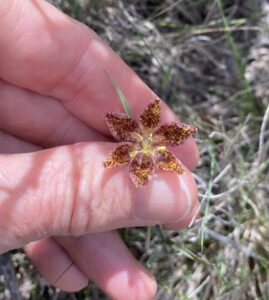BY HARRY WEEKES
 At the end of May, it seemed like the arrowleaf balsamroot intensified. What I thought was a peak in the early part of the month turned out to be the first wave of a yellow tsunami that swept across the hills behind our house. Determined to stand amidst this golden sea, I headed out the back, two dogs variously scampering in front, behind, and to the side of me.
At the end of May, it seemed like the arrowleaf balsamroot intensified. What I thought was a peak in the early part of the month turned out to be the first wave of a yellow tsunami that swept across the hills behind our house. Determined to stand amidst this golden sea, I headed out the back, two dogs variously scampering in front, behind, and to the side of me.
To reach the saddle behind my house takes 10 minutes. From there, I estimated another 10 would get me into the midst of the flowers. Determined in my quest, I stuck to the gully and wound my way through the sage. At one point, the three of us came upon a deer bedded down in a shaded alcove, and in about six snappy bounces it disappeared up the hillside. The dogs took an entire sniff census of the area, then caught up to me, where I waited in sight of the top. Here, I happened to see a dusky green flower bent over in the grass. I gently turned the top towards me and was surprised to see an intricate and beautiful design—a flower whose beauty was directed entirely back towards the ground.
I took a picture, vaguely thought, “There must be a lot of these hiding around here,” then continued my journey to the arrowleaf ocean.
While the balsamroot more than delivered (at one point, I simply burst out laughing and said to the dogs, “You’ve got to be kidding me,” at the sheer volume of blooms), I found myself mulling over another seed—that startlingly colored little flower, which turned out to be a spotted fritillary.
This also happens to be the name of a butterfly, with much the same patterning.
Over the next couple of days, I took the dogs to find the fritillary. And… came up empty. What I thought was going to be common turned out not to be. My chance encounter seemed to be just that, chance.
I got more intentional. I walked slower. I did my best to create a search image of a lone flower almost perfectly camouflaged against the sage, and I tried to enlist the dogs in my pursuit.
Nada.
Well, not nada. There were actually quite a few things. Like what I thought were accidental spider webs gummed up with clusters of some fuzz that turned out to be intentional constructions that were effectively luring in insects. There was death camas popping up. I learned both what alpine sheep sorrel is and also how beautiful its flower heads are. And that phlox colors range from completely white to an amazing pink.
Most importantly, though, I learned, again, about slowing down. About stopping frequently. About getting closer to the ground and remembering just how wonderful the smell of sagebrush is.
I learned that a hot dog and a deer aren’t too different—they will find shade, then quickly excavate a patch of cold dirt to lie in. And I learned that serendipity is a great word and a wonderful occurrence.
Olive found me, bent over, searching in the bushes. She tucked into the shade beside me… right under fritillaries. I could easily read into her expression a kind of smart-assy, “Are you looking for something?”
We stopped there for a while, each of us wrapped in our own little worlds—mine now just a little bit bigger because of a tiny flower hiding in plain sight in a thousand acres of sage.
Harry Weekes is the founder and head of school at The Sage School in Hailey. This is his 54th year in the Wood River Valley, where he lives with Hilary and their two mini-Dachshunds. The baby members of their flock have now become adults; Georgia and Simon are fledging in North Carolina, and Penelope has recently changed roosting sites to Connecticut.



